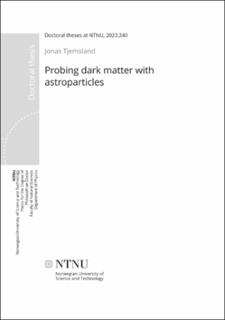Probing dark matter with astroparticles
Doctoral thesis
Permanent lenke
https://hdl.handle.net/11250/3096730Utgivelsesdato
2023Metadata
Vis full innførselSamlinger
- Institutt for fysikk [2677]
Sammendrag
There is an enormous amount of evidence for the existence of dark matter, from scales ranging from the faintest dwarf galaxies to the Universe as a whole. However, its nature remains a mystery. This thesis is a part of the community effort to reveal the properties of dark matter, focusing on how one can use gamma-rays and cosmic rays to indirectly probe its nature. Three main topics have been studied: cosmic ray antinuclei, photon-axion oscillations and millicharged particles.
Cosmic ray antinuclei, such as antideuterons and antihelions, are ideal detection channels for new and exotic physics – including dark matter annihilations or decays – due to low astrophysical backgrounds. At the same time, their composite structure and small binding energies make them excellent probes for particle correlations and density fluctuations in collider experiments, shedding light on the hadronization process or even the QCD phase diagram. In order to correctly interpret experimental data, a solid understanding of the antinucleus formation process is needed. The main focus in this thesis has therefore been to improve the theoretical description of the formation of (anti)deuteron and (anti)helion in small interacting systems, such as electron-positron, proton-proton and proton-nucleus collisions, and in particular, dark matter annihilations and decays. The main outcome has been a new and improved coalescence model, which takes into account both the size of the formation region and nucleon momentum correlations.
Axions and axion-like particles (ALPs) are interesting dark matter candidates despite their small masses. These particles are characterized by their two-photon coupling, which leads to so-called photon-ALP oscillations when photons propagate through a magnetic field. Parts of this thesis have been dedicated to study the distinctive signatures that these oscillations will imprint in the energy spectrum of high-energy photons from astrophysical sources. In particular, the detection of oscillatory features, or ``ALP wiggles'', in the photon spectra has been extensively studied.
Despite intensive searches, none of the traditional dark matter candidates have been found yet. This has lead to an increased interest in alternative candidates, such as hidden sectors. If the hidden sector is connected to the Standard Model with a massive dark photon as a mediator, the dark matter may have a small charge. This case is known as millicharged dark matter. Two topics related to millicharged particles have been studied: the production of light exotic particles by meson decays in air showers,
and the impact of millicharged dark matter on the evolution of the turbulence in the Milky Way.
Består av
Paper 1: Kachelriess, Michael; Ostapchenko, Sergey; Tjemsland, Jonas. Alternative coalescence model for deuteron, tritium, helium-3 and their antinuclei. European Physical Journal A 2020 ;Volum 56. https://doi.org/10.1140/epja/s10050-019-00007-9Paper 2: Kachelriess, Michael; Ostapchenko, Sergey; Tjemsland, Jonas. Revisiting cosmic ray antinuclei fluxes with a new coalescence model. Journal of Cosmology and Astroparticle Physics (JCAP) 2020 ;Volum 2020.(08) https://doi.org/10.1088/1475-7516/2020/08/048 - ArXiv ePrint: 2002.10481
Paper 3: Kachelriess, Michael; Tjemsland, Jonas. Reacceleration of charged dark matter. Journal of Cosmology and Astroparticle Physics (JCAP) 2020 ;Volum 2020.(10) https://doi.org/10.1088/1475-7516/2020/10/001 - ArXiv ePrint: 2006.10479
Paper 4: Kachelriess, Michael; Ostapchenko, S.; Tjemsland, Jonas. On nuclear coalescence in small interacting systems. European Physical Journal A 2021 ;Volum 57.(5) https://doi.org/10.1140/epja/s10050-021-00469-w This article is licensed under a Creative Commons Attribution 4.0 International License CC BY
Paper 6: Tjemsland, Jonas. Formation of light (anti)nuclei. Proceedings of Science (PoS) 2021 ;Volum 392. https://doi.org/10.22323/1.392.0006 - Copyright owned by the author(s) under the term of the Creative Commons Attribution-NonCommercial-NoDerivatives 4.0 International License.CC BY-NC-ND
Paper 7: Kachelriess, Michael; Tjemsland, Jonas. Meson production in air showers and the search for light exotic particles. Astroparticle physics 2021 ;Volum 132. Kachelriess, Michael; Tjemsland, Jonas. Meson production in air showers and the search for light exotic particles. Astroparticle physics 2021 ;Volum 132. https://doi.org/10.1016/j.astropartphys.2021.102622
Paper 8: Kachelriess, Michael; Ostapchenko, Sergey; Tjemsland, Jonas. On the origin and the detection of characteristic axion wiggles in photon spectra arXiv: 2111.08303
Paper 9: Kachelriess, Michael; Ostapchenko, Sergey; Tjemsland, Jonas. AAfrag 2.01: interpolation routines for Monte Carlo results on secondary production including light antinuclei in hadronic interactions. Computer Physics Communications 2023 ;Volum 287. https://doi.org/10.1016/j.cpc.2023.108698 This is an open access article under the CC BY license (http://creativecommons .org /licenses /by /4 .0/).
Paper 10: Kachelriess, Michael; Ostapchenko, Sergey; Tjemsland, Jonas. Effect of nonequal emission times and space-time correlations on (anti-) nuclei production. Physical Review C 2023 ;Volum 108.(2) https://doi.org/10.1103/PhysRevC.108.024903 - Published by the American Physical Society under the terms of the Creative Commons Attribution 4.0 International license CC BY
Paper 11: Kachelrieß, M.; Tjemsland, J. Detecting ALP wiggles at TeV energies arXiv: 2305.03604 [hep-ph]
